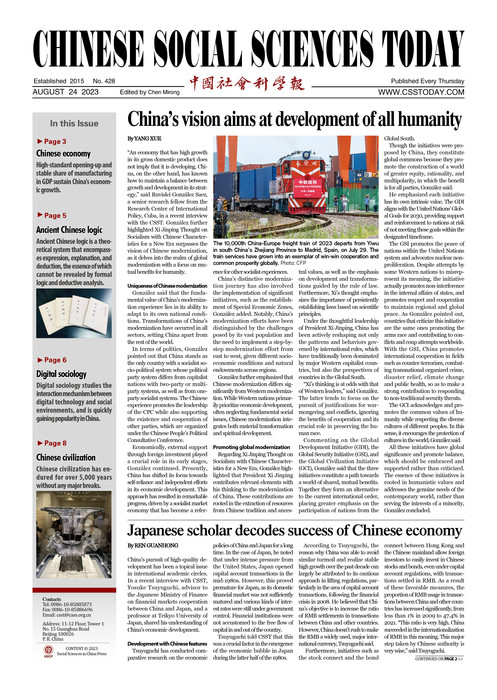Japanese scholar decodes success of Chinese economy
2023-08-24 14:33:17
By REN GUANHONG
China’s pursuit of high-quality development has been a topical issue in international academic circles. In a recent interview with CSST, Yosuke Tsuyuguchi, advisor to the Japanese Ministry of Finance on financial markets cooperation between China and Japan, and a professor at Teikyo University of Japan, shared his understanding of China’s economic development.
Development with Chinese features
Tsuyuguchi has conducted comparative research on the economic policies of China and Japan for a long time. In the case of Japan, he noted that under intense pressure from the United States, Japan opened capital account transactions in the mid-1980s. However, this proved premature for Japan, as its domestic financial market was not sufficiently matured and various kinds of interest rates were still under government control. Financial institutions were not accustomed to the free flow of capital in and out of the country.
Tsuyuguchi told CSST that this was a crucial factor in the emergence of the economic bubble in Japan during the latter half of the 1980s.
According to Tsuyuguchi, the reason why China was able to avoid similar turmoil and realize stable high growth over the past decade can largely be attributed to its cautious approach in lifting regulations, particularly in the area of capital account transactions, following the financial crisis in 2008. He believed that China’s objective is to increase the ratio of RMB settlements in transactions between China and other countries. However, China doesn’t rush to make the RMB a widely used, major international currency, Tsuyuguchi said.
Furthermore, initiatives such as the stock connect and the bond connect between Hong Kong and the Chinese mainland allow foreign investors to easily invest in Chinese stocks and bonds, even under capital account regulations, with transactions settled in RMB. As a result of these favorable measures, the proportion of RMB usage in transactions between China and other countries has increased significantly, from less than 1% in 2009 to 47.4% in 2021. “This ratio is very high. China succeeded in the internationalization of RMB in this meaning. This major step taken by Chinese authority is very wise,” said Tsuyuguchi.
Future ‘Chinese model’
Some Western scholars criticize the Chinese government for its extensive control over various sectors of the economy, arguing that this hampers efficiency and optimal economic performance and predicting this perceived inefficiency would slow China’s economic growth. In this regard, Tsuyuguchi holds a different view.
He believed that economic theories and policy measures cannot be mechanically applied to the development of a country. “China selected stable and rather high growth while the United States selected unstable but as high as possible growth, and so far, as a result, China succeeded better than other countries,” he said. In fact, at a conference in 2017, Tsuyuguchi proposed that if China can overcome the middle-income trap and continue to develop under its current system, a distinct “Chinese model” could emerge and gain recognition worldwide.
First floated by China’s leadership in 2020, the new development paradigm of “dual circulation” features domestic and overseas markets reinforcing each other with the domestic market as the mainstay, which represents a major adjustment and improvement of China’s economic development strategy. According to Tsuyuguchi, the concept of “dual circulation” entails greater emphasis on domestic demand than in the past.
Additionally, achieving high quality innovative development is closely tied to enhancing productivity, Tsuyuguchi said. The former aims at the demand side, while the latter aims at supply-side improvement. He further highlighted the importance of supply-side improvements, as China is expected to experience a decline in the labor force in the future. To maintain a reasonable growth rate, it becomes crucial to enhance productivity.
As Chinese manufacturing transitions towards high-quality technologies, factories that rely on relatively inexpensive labor may relocate to other developing countries. Tsuyuguchi commended this win-win practice, as it not only boosts productivity in China but also contributes to the development of those countries.



